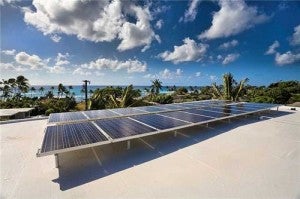 When people think Hawaiian paradise, usually beaches, sun and trade winds come to mind. The price of energy? Not so much.
When people think Hawaiian paradise, usually beaches, sun and trade winds come to mind. The price of energy? Not so much.
The state actually has the highest electric rates in the nation, approximately 2 to 3 times higher than the average price on the mainland. Given these high rates and the relatively mild climate, it makes sense that Hawaii’s customers are among the lowest monthly consumers of electricity at 585 kWh per month. However, despite low energy use, Hawaii’s customers still have the highest electric bills in the nation, at a whopping $203 per month on average. That’s 20 percent higher than the next highest state’s average bill!
It’s appropriate, then, that the Aloha State is on the forefront of policy measures intended to lower energy bills by looking to energy efficiency and renewable energy. Hawaii’s sunny days, coupled with its extraordinarily high cost of electricity, make going solar a relatively attractive option. And, not to mention, a much cleaner option given that the state relies on petroleum to generate over 75 percent of its electricity. In fact, Hawaii ranks third in the nation for total installed solar electric capacity per capita. However, the upfront cost of installation remains a significant barrier to widespread adoption of clean energy technologies. Access to financing is limited to those with stellar credit, and there is little incentive for renters to pay for energy upgrades to properties they don’t own. In Hawaii, solutions that work for renters are especially important since over 40 percent of the state’s residents rent.
But all is not lost. On February 1st, the Hawaii Public Utilities Commission (PUC) delivered a blueprint of a promising on-bill program to help residents and small commercial customers — including renters — invest in cost-saving, clean energy projects. By allowing for repayment of private financing for energy efficiency and renewable projects on customers’ monthly utility bills, Hawaii would be the first-in-the-nation to offer a statewide residential and small commercial on-bill program. The program works for renters and property owners because the energy benefits and the repayment obligation transfer from tenant to tenant with the property, enabling customers to invest in projects that outlast their terms of occupancy.
I had the pleasure of spending a few days in Hawaii last week to meet with stakeholders, discuss the State’s clean energy financing efforts on ‘Insights on PBS Hawaii’ and participate in the first working group established by the PUC to help meet the Jan 2, 2014 target start date for the on-bill program. With all of Hawaii’s utilities on board, high interest from key energy efficiency vendors and solar developers and the PUC signaling this issue is on a fast-track, EDF is confident in the group’s ability to achieve this goal. All signs point to more affordable, cleaner energy resources for both commercial and residential customers in Hawaii, which will save people money, create jobs and reduce harmful pollution. Sounds like paradise to me.











One Comment
Happy to see Hawaii moving forward with this. New York launched a statewide program for residential and small commercial on-bill recovery financing in January 2012 and July 2012, respectively, and is soon to launch on-bill recovery financing for multifamily buildngs.